2 中国科学院海洋研究所, 中国科学院海洋地质与环境重点实验室, 山东 青岛 266071)
印度季风是地球气候系统最活跃的组成部分之一,影响着近30亿人的生存和发展。研究认为,印度季风在新生代的演化与喜马拉雅-青藏高原生长、印度-阿拉伯海地区的地质演化和全球温度变化有密切关系[1~2]。在冬季,亚洲大陆北部上空出现高压,印度洋上的赤道低气压南移,东北风盛行,南亚地区气候相对寒冷干燥[3~4];在夏季,印度洋南部马斯克林高压与亚洲大陆的印度低压形成跨赤道压力梯度,西南季风盛行,给整个南亚地区和部分东亚地区带来丰富的降水[3]。在轨道尺度上,太阳辐射也影响着印度季风,使印度季风的变化显示偏心率(约100 ka)、斜率(约40 ka)、岁差(约21 ka)周期的变化,但是,关于控制印度季风长期变化的认识还存在着分歧[5~6]。Clemens等[7]发现印度季风在过去3.5 Ma相对于地球轨道变化的相位是不稳定的,在2.6 Ma、1.7 Ma和1.2~0.6 Ma经历了重要的主导周期转型,认为印度季风的演化,可能受到太阳辐射和北半球冰盖扩张的共同影响,季风的减弱加剧了南亚地区气候的干旱。但是,这些关于印度季风演化周期、转型和驱动机制的认识还有不同的意见,特别是,季风演化与构造活动、全球温度(冰量)、低纬太阳辐射量和大洋环流等的关系也还有不同的认识[4, 8~9]。
从印度板块和欧亚板块碰撞以后,新生代喜马拉雅和喀喇昆仑山的大量陆源碎屑物质被搬运并沉积在阿拉伯海和孟加拉湾以及印度洋地区[2, 10]。印度次大陆以西的阿拉伯海,作为世界两大陆源沉积物储库之一,发育了巨大的印度河海底扇[5]。其上覆盖的厚层新生代沉积物,保存了印度季风气候演化的丰富信息[5, 11~14],是研究印度季风演化历史的良好材料。在2015年春季,国际大洋发现计划355航次(简称IODP 355)在印度扇上钻探,获得了新生代以来两段1100多米厚的沉积物岩芯,时间跨度达到17.70 Ma,是认识晚新生代印度季风气候起源和演化的重要沉积记录[15]。其中,包含了高质量的第四纪沉积物的岩芯,并在船上通过古生物和古地磁分析建立了剖面的年代框架,得到了更新世(大约2.6 Ma)以来高分辨率风化和侵蚀的沉积记录[15~16],为认识印度季风的演化、冰期与间冰期的变化、沉积物的物源及动力过程等提供了良好的材料。本文多位作者全程参加了IODP 355航次的海上钻探采样工作,并于2015年夏季赴美国德克萨斯农工大学海湾岩芯库的实验室采集样品,参与完成了《Expedition 355 Preliminary Report:Arabian Sea Monsoon》报告的编写。本文利用从该航次获得的更新世高分辨率的沉积物样品,在古生物和古地磁分析建立的年代框架基础上,对阿拉伯海拉克希米盆地U1456钻孔A段的岩芯样品进行了粒度测试,分析研究区的沉积过程,探讨更新世以来印度季风的演化历史,为揭示印度季风变化特征和驱动机制提供基础资料。
1 材料与方法 1.1 研究区和样品采集阿拉伯海印度扇长1500 km,宽960 km,面积约1.12×106 km2。本次研究样品采自IODP 355航次U1456钻孔的岩芯(图 1)。钻孔U1456位于16°37.28′N、68°50.33′E,水深3640 m,东距印度海岸约475 km,向北距离现代印度河口约820 km。拉克希米海盆呈西北-东南走向,宽200~250 km,东侧平行于印度西海岸,西侧为拉克希米洋脊[16]。

|
图 1 研究区域位置及IODP 355航次钻孔分布图 图中黄色点标注本文目标钻孔U1456,玫红色点所标注处为本次航次另一个钻孔;改绘自文献[16] Fig. 1 Thestudy area and location of IODP 355 sites. The yellow solid circle indicates the location of Site U1456 and the pink solid circle indicates the other site in IODP 355, modified from reference[16] |
U1456钻孔由U1456A、U1456B、U1456C、U1456D和U1456E这5个深度不同的孔组成。本研究层段位于U1456A孔上部,总长345.36 m。0~121.36 m的沉积物主要为浅棕绿色的超微化石软泥夹杂着粘土、粉砂或砂;121.36~345.36 m的沉积物主要为深灰色到黑色的砂夹杂着浅棕灰色的富含超微化石的粘土。
1.2 实验方法本次实验样品采集工作在美国德克萨斯农工大学海湾岩芯库的实验室完成,以40 cm为间隔采样,共获得757个样品。样品的粒度实验测试在南京大学地理与海洋科学学院地表过程与环境实验室完成。在测量前对样品进行前处理,除去样品中生物组分,获得陆源组分。前处理方法在已有的基础上进行了调整[17],具体操作步骤如下:1)将样品在40 ℃下烘干,称重。2)称取约0.1 g样品,含生物化石丰富的样品以及砂质样品适当多称取一些,约0.1~0.2 g。3)除有机质:加10 %的双氧水10 ml,摇匀,静置1 h。4)除碳酸盐:加2 mol/L醋酸,加热至反应完全,烧杯中加满去离子水静置24 h,倒去上层清液。5)除生物硅:加6 %的NaOH溶液约15 ml,煮沸反应2h直至反应完全,加去离子水,静置24 h,倒去上层清液。6)加10 ml六偏磷酸钠溶液((NaPO3)6),超声波震荡10 min,使样品充分分散,上机测试。测量粒度使用的仪器为Mastersizer 2000型激光粒度仪,该仪器测量范围为0.02~2000 μm,多次重复测量误差小于3 %。将上机测试获得的陆源碎屑按粒径大小分为粘土(< 4 μm)、粉砂(4~63 μm)、砂(63~2000 μm)三大组分进行讨论。
1.3 年代标尺的建立IODP 355航次通过对钻孔不同深度的钙质超微化石、浮游有孔虫、放射虫以及硅藻的年代信息,获得了基本的生物地层年代框架。通过对钻孔的古地磁和岩石磁性学研究,确立了地磁极性年代框架[15]。据此,本文利用生物地层和地磁年代作为年龄控制点(表 1),进行线性插值和外推,获得时间标尺。在早更新世,沉积速率很高,达到33 cm/ka;晚早更新世至今沉积速率降低,约为13 cm/ka(图 2);剖面底部的年代为约1.78 Ma。
| 表 1 U1456A生物地层和古地磁年代控制点[15] Table 1 Biostratigraphy datums and magnetic polarity tie points of Site U1456A[15] |

|
图 2 U1456A地层年代框架 上段沉积速率为约13 cm/ka,下段沉积速率为约33 cm/ka Fig. 2 Age-depthplot of Site U1456A. The upper part accumulation rate is about 13 cm/ka, the lower part accumulation rate is about 33 cm/ka |
U1456A主要由粘土质粉砂组成,并伴有可以指示深海环境的蚕沙化石相[18]。在剖面最上部发现了指示深海环境的痕迹化石虫孔[15],表明这套沉积物是典型深海沉积环境下的产物。沉积序列表现出明显的浊流沉积的特点,如图 3所示,其底部冲刷沉积,与下部呈现突变接触,有明显的侵蚀冲刷面。在沉积层内部,发育正粒序韵律结构,粒度从下向上逐渐减小,接触面不明显。在整个研究剖面几乎每个粘土、粉砂、砂层均含有许多类似图 3所示的浊流沉积层。此外,根据地震剖面资料[19~21],在钻孔附近层序含有典型“下切-充填”水道沉积特征,证明该层序沉积过程由海底水道天然复合堤控制,为典型的深海浊流沉积层。同时,由于阿拉伯海存在受印度季风驱动的表层洋流,因此研究区的沉积物中可能还含有部分由洋流输运的悬浮沉积物[22]。从钻孔沉积物的粒序结构和沉积结构看,洋流悬浮沉积物对沉积序列不起决定性作用,浊流沉积过程起主导作用。在早更新世,沉积速率很高,达到33 cm/ka;在晚早更新世至今沉积速率降低,约为13 cm/ka。

|
图 3 钻孔中不同深度正粒序结构的浊流沉积 红色箭头指示侵蚀冲刷面的位置,图下注释分别为沉积在钻孔上位置和深度(图片信息引自:http://publications.iodp.org/proceedings/355/EXP_REPT/CORES/IMAGES/) Fig. 3 Stackedturbidites feature showing normal grading in different depth of Site U1456A. The red arrows indicate the ravinement surface. Information of each turbiditie of the core and depth is under the picture. All pictures are downloaded from http://publications.iodp.org/proceedings/355/EXP_REPT/CORES/IMAGES/ |
样品粒度分析结果表明,U1456A钻孔沉积物中的陆源组分由粘土、粉砂和砂组成(图 4)。其中,粉砂含量在19.8 % ~93.9 %之间,平均含量达73.7 %,占绝对的主体;粘土含量在1.8 % ~52.8 %之间,平均含量为14.7 %;砂含量平均为11.6 %,主要为细砂和极细砂,其含量变化幅度很大,在0~78.4 %之间波动。整个剖面平均粒径分布在5.9~190.8 μm,平均值为39.7 μm,属于粗粉砂范围。

|
图 4 4U1456A钻孔地层、平均粒径和各粒级组分随深度变化岩性剖面引自文献[15] Fig. 4 Lithostratigraphyand variation of mean grain size, clay, silt, sand fractions with depth of Site U1456A. Lithostratigraphyiscited from reference[15] |
根据粒度各组分随深度变化的特征可以看出,该钻孔陆源组分粒度在144.06 m处粒度发生了明显的变化,因此,以144.06 m为分界线,将地层划分为上下两段。在下段(345.36~144.06 m)沉积物粒度整体较粗,平均粒径分布在6.0~190.8 μm之间,平均值为54.2 μm。砂粒级含量较高,平均值为13.6 %,在0~78.4 %间波动;粉砂含量的平均值为71.9 %,在19.8 % ~93.9 %间波动;粘土含量的平均值为14.5 %,在1.8 % ~52.8 %间波动;砂粒级和粘土粒级含量呈现出明显相反的变化特征,波动幅度超过40 %。上段(144.06~0 m)沉积物较下段沉积物粒度整体变细,分布在5.9~143.6 μm之间,平均粒径为19.3 μm。砂粒级含量虽然波动仍然较大(0~78.4 %),但相比下段整体减少,平均值为8.8 %;粉砂含量的平均值为76.3 %,在19.8 % ~91.7 %间波动;粘土含量的平均值为14.9 %,在1.8 % ~30.3 %间波动。相比下段,在上段仅有极少数样品的砂粒级含量超过了40 %。
从平均粒径和砂组分随年代变化(图 5)中可以清晰的看到,在整个沉积序列砂组分含量变化较大,并存在一定的周期性变化特征。在1.18 Ma以前,砂组分含量变化周期短、频率高;1.18 Ma以后,砂组分含量变化周期变长、频率变低。

|
图 5 U1456 A钻孔沉积物平均粒径、砂含量变化及其与深海氧同位素[23]、海平面变化[24]曲线对比 Fig. 5 Variationof mean grain size, percentage of sand fraction, the LR04 benthic δ18O stack[23] and the sea level change[24] |
浊流沉积是深海中常见并且分布较广的一种沉积形式,是由于流体中湍动悬浮着的沉积物所造成的密度差异而引起流动的重力流沉积,可以在极缓的斜坡上流动,搬运堆积大量的沉积物[25]。大型滑塌的后期也常导致大规模的水下碎屑流和浊流发生,从而形成分布广泛的碎屑流和浊流沉积。通过对沉积动力过程的研究,海底浊流沉积主要由1)陆源物质的输入;2)区域的构造和地质活动;3)海平面变化这3个因素影响[25~28]。
首先,在讨论浊流沉积过程时,需要确定其物质来源。U1456钻孔的重矿物切片和XRD分析结果表明,上下段岩芯沉积物中的矿物组成基本相同,均存在电气石、绿帘石、硅线石以及大量的白云母等矿物,指示其物源与印度河具有紧密的联系[15, 29]。此外,在下段中发现蓝闪石和紫苏辉石,也明确指示沉积物来自有一系列俯冲岩石暴露的印度缝合带[15]。前人的研究也证明,阿拉伯海的沉积物主要为印度河搬运的印度缝合带及喜马拉雅造山带的物质[30~32];而通过对U1456A钻孔样品进行Sr-Nd同位素分析和锆石U-Th-Pb年龄的测定,进一步证实第四纪以来研究区沉积物主要来自喜马拉雅造山带及其北侧喀喇昆仑和科西斯坦-拉达克地区[33]。另一个可能的物源为位于印度半岛上的纳巴达河和拉布蒂河,但是,这两条河流的输运量仅为印度河的四分之一[34~35],且印度半岛西侧大陆架宽广,对河流输送的物质具有较好的缓冲作用[36],因此,它们对研究区物源的贡献相对较少。综上所述,我们认为由印度河输运的来自喜马拉雅造山带和喀喇昆仑山系及邻区的风化剥蚀物质是U1456A钻孔浊流沉积的主要来源。
在物源确定的情况下,源区风化剥蚀的强度和印度河的输运能力决定了研究区沉积序列的陆源组分颗粒大小和沉积速率[25]。在上新世尤其是更新世以来,季风是控制喜马拉雅山脉-青藏高原南部陆地风化、剥蚀的最主要因素[37],从而控制着印度扇内的浊流沉积物的特性以及砂/泥比例[38~39]。在喜马拉雅山脉-青藏高原南部的剥蚀物质源区,季风强弱决定着其降水强度[40]。在印度季风降水增多时,季风降水对源区的风化和剥蚀作用增强,使大量的风化剥蚀产物进入印度河,甚至可以引发大规模的山洪和滑坡[41],产生大量粗颗粒物质入海。同时,强降水也使河流径流增大,水动力增强,输运的沉积物粒径增大,沉积物堆积量增加[42]。有研究证明,在印度季风增强阶段,印度河、恒河的沉积物输运量以及其三角洲上的沉积物堆积量明显增加[43~44];反之,在季风减弱时期,印度河带来的陆源物质减少,且粒径偏细[19, 32, 40, 45]。因此,印度季风的强弱可以直接控制印度扇内沉积物的粒径大小和沉积速率。
在构造尺度上的认识认为,整个喜马拉雅造山带至少在早更新世就已经形成了现在的格局[46~47],因此第四纪以来印度河带来陆源碎屑物的量更多反应的是气候变化对源区风化、剥蚀作用的影响。关于陆源物质入海后的沉积过程,广阔覆盖区的地震资料证实,自上新世以来,在印度扇表面发育大量的浊流通道,研究区沉积地层平坦,整个区域的地质构造是基本稳定的[19, 21, 48~49]。沉积物在阿拉伯海的输送主要通过印度大陆架,经由大陆坡上存在着的峡谷复合体和在上扇发育着丰富的水道-天然堤复合体,浊流沿着水道,依次在上扇、中扇和下扇形成浊流沉积[50]。此外,研究区还存在部分由表层洋流带来的悬浮沉积物[22]。阿拉伯海的表层洋流主要受到印度季风的驱动,在夏季风盛行期间,阿拉伯海沿岸地区的表层洋流呈顺时针方向流动,将印度河三角洲的陆源物质向东阿拉伯海输运,这与浊流沉积在海底河道向研究区的输运方向一致[22]。当南亚夏季风增强,阿拉伯海表层洋流对印度河三角洲的陆源物质的输运能力增强,沉积物粒径增粗[51]。这与上文论述的浊流沉积物的粒度对季风降水的响应具有一致性。
此外,海平面变化也可能对深海沉积过程产生着影响[52~53]。前人[38, 54]通过对阿拉伯海北部海底峡谷、陆坡以及上扇地区的沉积物研究,发现高海平面时期,陆架被海水淹没,导致陆源沉积物入海后易在陆架或相邻陆坡上沉积,滑坡和浊流活动频率降低,沉积物粒径变细;相反,低海平面时期,印度河河口可以直接与海底峡谷相连,大量陆源物质通过宽且深的海底峡谷、海底河道输运,滑塌频发。认为相比高海平面时期,低海平面时期更易发生浊流沉积且颗粒偏粗[38, 55~56]。但是,我们对比研究区的粒度数据与海平面变化发现(图 5),从长时间尺度上看,以1.18 Ma为界,下段的海平面高,波动较小,上段的海平面低,海平面变化幅度开始加剧,海平面明显下降,在- 107.38~4.00 m间波动,但是沉积物粒度却显示1.80~1.18 Ma到1.18~0.10 Ma阶段,平均粒径明显变细,砂组分含量减少,与前人[38, 54, 56]在阿拉伯海北部总结出的海平面变化对沉积物粒径的影响结果不符。再考虑到研究区距离印度河河口较远,研究区水深达数千米,而第四纪冰期-间冰期海平面只有数十米到近百米的变化,这样的海面变化难以改变阿拉伯海的环流格局、沉积过程和浊流发育过程,因此,海平面变化可能不是决定浊流沉积物特征的决定性因素。综上,印度季风降水的强度直接控制着沉积在河口、海岸带和陆架沉积物物颗粒的大小,U456A钻孔的沉积物的粒度和沉积速率可以很好的反映印度季风的强度。
从整体来看(图 2、图 4和图 5),U1456A剖面的沉积速率、物质组成和砂组分粒径在下段(1.80~1.18 Ma)到上段(1.18~0.10 Ma)都发生了明显的变化。从下段到上段,沉积厚度明显变薄,沉积序列平均沉积速率从约33 cm/ka减小到约13 cm/ka。沉积物组成从下段主要为砂和粉砂夹杂着粘土组分,转变为上段主要为深海组分的超微化石软泥,夹杂有少量的砂层或粉砂层。通过对陆源组分进行粒度分析,发现平均粒径明显减小,砂粒组分含量明显减少,粒度整体变细。反映了1.18 Ma以来印度季风强度的减弱。在阿拉伯海西部,Clemens等[7]将有孔虫(Globigerina bulloides)含量和风成沉积物平均粒径作为判定印度季风变化的良好指标,认为在1.2 Ma有孔虫含量的增多和风成沉积物平均粒径的减小指示了印度季风在1.2 Ma的减弱。此结论也与本文印度季风在1.18 Ma减弱的结论有较好的一致性。
3.2 中更新世气候转型与印度季风气候变化在构造时间尺度,我们认为U1456A沉积序列可以作为印度季风气候变化的重要记录。在1.18 Ma以来,印度扇陆源沉积量整体减少、沉积速率减慢、粒度变细,反映了印度季风在中更新世阶段性减弱,可能与当时的气候转型有关。中更新世气候转型时期,北半球冰盖进一步扩大,全球温度在1.2 Ma开始出现明显的下降趋势,Herbert等[57]和Mcclymont等[58]分别对阿拉伯海和全球的海面温度进行重建,也发现从1.2 Ma左右开始海面温度具有明显的下降趋势,气候变化周期由41 ka向100 ka发生转变[58~59]。
我们对新获得的粒度砂组分含量变化的时间序列进行了最大熵谱频谱分析和小波变换分析(图 6)。结果表明,在1.80~1.18 Ma期间存在约41 ka的周期,而在1.18~0.10 Ma期间显示出约250 ka和约80 ka两个主周期,且这一周期转型大致发生在中更新世气候转型期(1.2~0.9 Ma),这与中更新世冰量变化周期从约41 ka向约100 ka转变基本吻合[60~63]。表明在轨道时间尺度上,全球温度、冰量变化驱动的印度季风变化可能主导了印度扇沉积物颗粒粗细的周期变化。然而,由于缺乏更多准确的年代控制点,我们所获得的U1456A沉积序列的时间标尺较为粗略,存在一定的不确定性,尚不足以实现轨道尺度上和深海氧同位素序列的精细对比。

|
图 6 U1456A钻孔粒度时间序列频谱分析和小波分析结果(a)、(b)分别为0.10~1.18 Ma、1.18~1.80 Ma频谱分析;(c)为小波分析图 Fig. 6 U1456Acore grain size time series spectrum analysis and wavelet analysis, (a) and(b) show the spectrum analysis of 0.10~1.18 Ma and 1.18~1.80 Ma, and (c)shows the wavelet analysis result |
基于以上分析,推测印度扇上U1456A钻孔浊流沉积过程的周期变化是对中更新世气候转型的响应。同时,中更新世以来全球变冷,北半球冰量持续扩大,也可能是导致印度季风减弱的原因。但由于印度季风是一个复杂的气候系统,影响印度季风的因素多,因此关于印度季风的影响机制还需要进一步的研究。
4 结论通过对IODP 355航次阿拉伯海拉克希米盆地U1456钻孔A段345.36 m的沉积物进行沉积特征分析,发现研究区沉积物为典型的深海浊流沉积,沉积序列记录了近1.8 Ma以来浊流过程变化历史。通过对其粒径分布、沉积过程和现有资料的研究分析,判定印度河输运的来自喜马拉雅造山带和喀喇昆仑山系及邻区的风化剥蚀物质是研究区沉积物的主要来源,研究区沉积序列在构造时间尺度上的粒度变化主要受到印度季风降水控制,构造活动和海平面变化对其的影响较小。1.18 Ma开始U1456A钻孔沉积速率减慢,陆源沉积物减少,沉积序列粒度变细,砂组分含量减少,揭示了中更新世印度季风的阶段性减弱,降水量减少。同时,对粒度砂粒组分含量变化的时间序列进行最大熵谱频谱分析和小波变换分析,显示沉积物粒度变化周期在1.18 Ma发生从41 ka向长周期转变。推测阿拉伯海拉U1456A沉积序列粒度在中更新世的变化可能是对此时气候转型的响应。全球温度(冰量)变化可能是驱动第四纪印度季风气候长期变化的主导因素。
致谢: 感谢王颖院士、陈骏院士、弋双文高工、张瀚之博士、杨传彬先生、程临海先生等在申请项目和实验室测试等给予的大力帮助。
| [1] |
Molnar P, England P, Martinod J. Mantle dynamics, uplift of the Tibetan Plateau, and the Indian monsoon[J]. Reviews of Geophysics, 1993, 31(4): 357-396. DOI:10.1029/93RG02030 |
| [2] |
鹿化煜, 常宏, 郭正堂, 等. 大陆碰撞、高原生长和气候演化——2014年Crafoord奖获得者Peter Molnar教授成就解读[J]. 中国科学:地球科学, 2015, 45(6): 770-775. Lu Huayu, Chang Hong, Guo Zhengtang, et al. The continental collision, plateau uplift and climate evolution:An interpretation of Prof. Peter Molnar's achievement, the Prize winner of the Crafoord Awards in 2014[J]. Science China:Earth Sciences, 2015, 45(6): 770-775. |
| [3] |
Ding Y. Monsoons over China[M]. Dotricht/Boston/London: Kluwer Academic Publisher, 1994: 252.
|
| [4] |
Wang P X, Wang B, Cheng H, et al. The global monsoon across time scales:Mechanisms and outstanding issues[J]. Earth-Science Reviews, 2017, 174: 84-121. DOI:10.1016/j.earscirev.2017.07.006 |
| [5] |
Clemens S, Prell W, Murray D, et al. Forcing mechanisms of the Indian Ocean monsoon[J]. Nature, 1991, 353(6346): 720-725. DOI:10.1038/353720a0 |
| [6] |
Ruddiman W F. What is the timing of orbital-scale monsoon changes[J]. Quaternary Science Reviews, 2006, 25(7): 657-658. |
| [7] |
Clemens S C, Murray D W, Prell W L. Nonstationary phase of the Plio-Pleistocene Asian monsoon[J]. Science, 1996, 274(5289): 943-948. DOI:10.1126/science.274.5289.943 |
| [8] |
汪品先. 全球季风的地质演变[J]. 科学通报, 2009, 54(5): 535-556. Wang Pinxian. Global monsoon in a geological perspective[J]. Chinese Science Bulletin, 2009, 54(5): 535-556. |
| [9] |
肖海丰, 沈吉, 肖霞云. 云南鹤庆钻孔揭示的西南季风轨道尺度演化[J]. 第四纪研究, 2006, 26(2): 274-282. Xiao Haifeng, Shen Ji, Xiao Xiayun. The orbital scale evolution of the southwest monsoon reflected by the Heqing core in Yunnan Province[J]. Quaternary Sciences, 2006, 26(2): 274-282. DOI:10.3321/j.issn:1001-7410.2006.02.016 |
| [10] |
Clift P, Gaedicke C, Edwards R, et al. The stratigraphic evolution of the Indus Fan and the history of sedimentation in the Arabian Sea[J]. Marine Geophysical Researches, 2002, 23(3): 223-245. DOI:10.1023/A:1023627123093 |
| [11] |
Prell W L, Campo E V. Coherent response of Arabian Sea upwelling and pollen transport to Late Quaternary monsoonal winds[J]. Nature, 1986, 323(6088): 526-528. DOI:10.1038/323526a0 |
| [12] |
Prell W L, Murray D W, Clemens S C, et al. Evolution and variability of the Indian Ocean summer monsoon: Evidence from the western Arabian sea drilling program[C]//Duncan R A, Rea D K, Kidd R B, et al. The Indian Ocean: A Synthesis of Results from the Ocean Drilling Program: Geophysical Monograph Series. Washington D C: American Geophysical Union, 1992, 70: 447-469.
|
| [13] |
Clemens S C, Prell W L. A 350, 000 year summer-monsoon multi-proxy stack from the Owen Ridge, Northern Arabian Sea[J]. Marine Geology, 2003, 201(1-3): 35-51. DOI:10.1016/S0025-3227(03)00207-X |
| [14] |
Kroon D. Onset of Monsoonal Related Upwelling in the Western Arabian Sea as Revealed by Planktonic Foraminifers[C]//Prell W L, Niitsuma N, et al. Proceedings of the Ocean Drilling Program Scientific Results, 117. Texas: Texas A & M University, 1991: 257-263.
|
| [15] |
Pandey D K, Clift P D, Kulhanek D K, et al. Site U1456[C]//Pandey D K, Clift P D, Kulhanek D K, et al. Proceedings of the International Ocean Discovery Program Volume 355. Texas: Texas A & M University, 2016, 103: 1-61.
|
| [16] |
Pandey D K, Clift P D, Kulhanek D K, et al. Expedition 355 summary[C]//Pandey D K, Clift P D, Kulhanek D K, et al. Proceedings of the International Ocean Discovery Program Volume 355. Texas: Texas A & M University, 2016, 101: 1-31.
|
| [17] |
鹿化煜, 安芷生. 洛川黄土粒度组成的古气候意义[J]. 科学通报, 1997, 42(1): 66-69. Lu Huayu, An Zhisheng. Palaeoclimatic implication of grain-size composition record in Luochuan loess[J]. Chinese Science Bulletin, 1997, 42(1): 66-69. DOI:10.3321/j.issn:0023-074X.1997.01.020 |
| [18] |
Seilacher A. Bathymetry of trace fossils[J]. Marine Geology, 1967, 5(5): 413-428. |
| [19] |
Kolla V, Coumes F. Morphology, internal structure, seismic stratigraphy, and sedimentation of Indus Fan[J]. American Association of Petroleum Geologists Bulletin, 1987, 71(6): 650-677. |
| [20] |
Mishra R, Pandey D K, Ramesh P. Active channel systems in the middle Indus fan:Results from high-resolution bathymetry surveys[J]. Current Science, 2015, 108(3): 409-412. |
| [21] |
Mishra R, Pandey D K, Ramesh P, et al. Identification of new deep sea sinuous channels in the eastern Arabian Sea[J]. Springerplus, 2016, 5(1): 1-18. DOI:10.1186/s40064-015-1659-2 |
| [22] |
Asmussen S, Møller J R. The monsoon circulation of the Indian Ocean[J]. Progress in Oceanography, 2001, 51(1): 1-123. |
| [23] |
Lisiecki L E, Raymo M E. A Pliocene-Pleistocene stack of 57 globally distributed benthic δ18O records[J]. Paleoceanography, 2005, 20(1): 1-16. DOI:10.1029/2004PA001071 |
| [24] |
Rohling E J, Foster G L, Grant K M, et al. Corrigendum:Sea-level and deep-sea-temperature variability over the past 5.3 million years[J]. Nature, 2014, 508(7497): 477-482. DOI:10.1038/nature13230 |
| [25] |
王良忱, 张金亮. 沉积环境和沉积相[M]. 北京: 石油工业出版社, 1996: 119-136. Wang Liangchen, Zhang Jinliang. Sedimemtary Environment and Sedimentary Facies[M]. Beijing: Petroleum Industry Press, 1996: 119-136. |
| [26] |
Prins M A, Postma G. Effects of climate, sea level, and tectonics unraveled for last deglaciation turbidite records of the Arabian Sea[J]. Geology, 2000, 28(4): 375-378. DOI:10.1130/0091-7613(2000)28<375:EOCSLA>2.0.CO;2 |
| [27] |
Steinke S, Kienast M, Hanebuth T. On the significance of sea-level variations and shelf paleo-morphology in governing sedimentation in the southern South China Sea during the last deglaciation[J]. Marine Geology, 2003, 201(1-3): 179-206. DOI:10.1016/S0025-3227(03)00216-0 |
| [28] |
方念乔, 陈学方, 胡超涌, 等. 东北印度洋深海记录基本特征及其对青藏高原隆升的响应[J]. 第四纪研究, 2001, 21(6): 490-499. Fang Nianqiao, Chen Xuefang, Hu Chaoyong, et al. Deep sea sedimentary records in the northeastern Indian Ocean and their response to the uplift of the Qinghai-Xizang Plateau[J]. Quaternary Sciences, 2001, 21(6): 490-499. DOI:10.3321/j.issn:1001-7410.2001.06.004 |
| [29] |
Garzanti E, Vezzoli G, Andò S, et al. Petrology of Indus River sands:A key to interpret erosion history of the Western Himalayan Syntaxis[J]. Earth and Planetary Science Letters, 2005, 229(3-4): 287-302. DOI:10.1016/j.epsl.2004.11.008 |
| [30] |
Milliman J D, Quraishee G S, Beg M A A. Sediment discharge from the Indus River to the ocean: Past, present and future[C]//Haq B U, Milliman J D. Marine Geology and Oceanography of Arabian Sea and Coastal Pakistan. New York: Van Nostrand Reinhold, 1984: 65-70.
|
| [31] |
Qayyum M, Lawrence R D, Niem A R. Discovery of the palaeo-Indus delta-fan complex[J]. Journal of the Geological Society, 1997, 154(5): 753-756. DOI:10.1144/gsjgs.154.5.0753 |
| [32] |
Clift P D, Shimizu N, Layne G D, et al. Development of the Indus Fan and its significance for the erosional history of the western Himalaya and Karakoram[J]. Geological Society of America Bulletin, 2001, 113(8): 1039-1051. DOI:10.1130/0016-7606(2001)113<1039:DOTIFA>2.0.CO;2 |
| [33] |
程临海.早更新世至中更新世阿拉伯海沉积物物源变化的Sr-Nd及锆石U-Pb同位素研究[D].南京: 南京大学学士学位论文, 2017: 1-35. Cheng Linhai. Sr-Nd Isotope and Zircon U-Pb Isotopes Dating Analysis from Early Pleistocene to Middle Pleistocene Unravel Sediment Source Changes in the Arabian Sea[D]. Nanjing: The Undergraduate Thesis of Nanjing University, 2017: 1-35. |
| [34] |
Milliman J D, Syvitski J P M. Geomorphic/tectonic control of sediment discharge to the Ocean:The importance of small mountainous rivers[J]. Journal of Geology, 1992, 100(5): 525-544. DOI:10.1086/629606 |
| [35] |
Alagarsamy R, Zhang J. Comparative studies on trace metal geochemistry in Indian and Chinese rivers[J]. Current Science, 2005, 89(2): 299-309. |
| [36] |
Rao V P, Wagle B G. Geomorphology and surficial geology of the Western continental shelf and slope of India:A review[J]. Current Science, 1997, 73(4): 330-350. |
| [37] |
Clift P D. Controls on the erosion of Cenozoic Asia and the flux of clastic sediment to the ocean[J]. Earth and Planetary Science Letters, 2006, 241(3): 571-580. |
| [38] |
Bourget J, Zaragosi S, Ellouz-Zimmermann S, et al. Highstand vs. lowstand turbidite system growth in the Makran active margin:Imprints of high-frequency external controls on sediment delivery mechanisms to deep water systems[J]. Marine Geology, 2010, 274(1): 187-208. |
| [39] |
Caley T, Malaizé B, Zaragosi S, et al. New Arabian Sea records help decipher orbital timing of Indo-Asian monsoon[J]. Earth and Planetary Science Letters, 2011, 308(3): 433-444. |
| [40] |
Clift P D, Hodges K V, Heslop D, et al. Correlation of Himalayan exhumation rates and Asian monsoon intensity[J]. Nature Geoscience, 2008, 1(12): 875-880. DOI:10.1038/ngeo351 |
| [41] |
Bookhagen B, Thiede R C, Strecker M R. Late Quaternary intensified monsoon phases control landscape evolution in the northwest Himalaya[J]. Geology, 2005, 33(2): 149-152. DOI:10.1130/G20982.1 |
| [42] |
Friedman G M, Sanders J E. Principles of Sedimentology[M]. New York: Wiley, 1978: 5-121.
|
| [43] |
Clift P D, Giosan L. Sediment fluxes and buffering in the post-glacial Indus Basin[J]. Basin Research, 2014, 26(3): 369-386. DOI:10.1111/bre.2014.26.issue-3 |
| [44] |
Goodbred S L J, Kuehl S A. Enormous Ganges-Brahmaputra sediment discharge during strengthened Early Holocene monsoon[J]. Geology, 2000, 28(12): 1083-1086. DOI:10.1130/0091-7613(2000)28<1083:EGSDDS>2.0.CO;2 |
| [45] |
Clift P D, Shimizu N, Layne G D, et al. Tracing patterns of erosion and drainage in the Paleogene Himalaya through ion probe Pb isotope analysis of detrital K-feldspars in the Indus Molasse, India[J]. Earth and Planetary Science Letters, 2001, 188(3-4): 475-491. DOI:10.1016/S0012-821X(01)00346-6 |
| [46] |
Bouquillo A, France-Lanord C, Michard A, et al. Sedimentology and isotopic chemistry of the Bengal Fan sediments: The denudation of the Himalaya[C]//Coehran J R, Stow D A V, et al. Proceedings of the Ocean Drilling Program, Scientific Results. Texas: Texas A & M University, 1990: 45-58.
|
| [47] |
Francelanord C, Derry L, Michard A. Evolution of the Himalaya since Miocene time:Isotopic and sedimentological evidence from the Bengal Fan[J]. Geological Society London Special Publications, 1993, 74(1): 603-621. DOI:10.1144/GSL.SP.1993.074.01.40 |
| [48] |
Coumes V K F. Channel migration in upper Indus Fan in relation to geologic history of region:Abstract[J]. American Association of Petroleum Geologists Bulletin, 1984, 68(4): 466-466. |
| [49] |
Mchargue T R, Webb J E. Internal geometry, seismic facies, and petroleum potential of canyons and inner fan channels of the Indus submarine fan[J]. American Association of Petroleum Geologists Bulletin, 1986, 70(2): 161-180. |
| [50] |
威尔格斯C K. 层序地层学原理:海平面变化综合分析[M]. 北京: 石油工业出版社, 1993: 443-456. Wilgus C K. The Principle of Sequence Stratigraphy:Comprehensive Analysis of Sea Level Change[M]. Beijing: Petroleum Industry Press, 1993: 443-456. |
| [51] |
Goswami V, Singh S K, Bhushan R, et al. Temporal variations in 87Sr/86Sr and εNd, in sediments of the southeastern Arabian Sea:Impact of monsoon and surface water circulation[J]. Geochemistry, Geophysics, Geosystems, 2013, 13(1): 1-13. |
| [52] |
Posamentier H W, Jervey M T, Vail P R. Eustatic control on clastic deposition Ⅰ-Conceptual framework[C]//Wilgus C K, Hastings B S, Posamentier H W, et al. Sea Level Change: An Integrated Approach, Special Publication, No 42. New York: The Society of Economic Paleontologists and Mineralogists, 1988: 109-124.
|
| [53] |
Steinke S, Hanebuth T J J, Vogt C, et al. Sea level induced variations in clay mineral composition in the southwestern South China Sea over the past 17, 000 yr[J]. Marine Geology, 2008, 250(3-4): 199-210. DOI:10.1016/j.margeo.2008.01.005 |
| [54] |
Prins M A, Postma G, Weltje G J. Controls on terrigenous sediment supply to the Arabian Sea during the Late Quaternary:The Makran continental slope[J]. Marine Geology, 2000, 169(3): 351-371. |
| [55] |
Bourget J, Zaragosi S, Rodriguez M, et al. Late Quaternary megaturbidites of the Indus Fan:Origin and stratigraphic significance[J]. Marine Geology, 2013, 336(1): 10-23. |
| [56] |
Clift P D, Giosan L, Henstock T J, et al. Sediment storage and reworking on the shelf and in the Canyon of the Indus River-Fan System since the Last Glacial Maximum[J]. Basin Research, 2014, 26(1): 183-202. DOI:10.1111/bre.2014.26.issue-1 |
| [57] |
Herbert T D, Peterson, Liu Z. Tropical ocean temperatures over the past 3.5 million years[J]. Science, 2010, 328(5985): 1530-1534. DOI:10.1126/science.1185435 |
| [58] |
Mcclymont E L, Sosdian S M, Rosell-Melé A, et al. Pleistocene sea-surface temperature evolution:Early cooling, delayed glacial intensification, and implications for the mid-Pleistocene climate transition[J]. Earth-Science Reviews, 2013, 123(4): 173-193. |
| [59] |
Clark P U, Archer D, Pollard D, et al. The Middle Pleistocene transition:Characteristics, mechanisms, and implication for long-term changes in atmospheric pCO2[J]. Quaternary Science Reviews, 2006, 25(23): 3150-3184. |
| [60] |
Ruddiman W F, Raymo M E, Martinson D G, et al. Pleistocene evolution:Northern hemisphere ice sheets and North Atlantic Ocean[J]. Paleoceanography, 1989, 4(4): 353-412. DOI:10.1029/PA004i004p00353 |
| [61] |
Raymo M E, Lisiecki L E, Nisancioglu K H. Plio-Pleistocene ice volume, Antarctic climate, and the global δ18O record[J]. Science, 2006, 313(5786): 492-495. DOI:10.1126/science.1123296 |
| [62] |
Sosdian S, Rosenthal Y. Deep-sea temperature and ice volume changes across the Pliocene-Pleistocene climate transitions[J]. Science, 2009, 325(5938): 306-310. DOI:10.1126/science.1169938 |
| [63] |
Yin Q Z, Berger A. Insolation and CO2 contribution to the interglacial climate before and after the Mid-Brunhes Event[J]. Nature Geoscience, 2010, 3(4): 243-246. DOI:10.1038/ngeo771 |
2 Key Laboratory of Marine Geology and Environment, Institute of Oceanology, Chinese Academy of Sciences, Qingdao 266071, Shandong)
Abstract
The Indus fan is supplied by the eroded sediments from the Himalayas and adjacent mountain ranges in South Asia. It provides an ideal sedimentary archive for studying the Indian monsoon evolution during the Late Cenozoic. Texture and sedimentological data from the IODP Hole U1456A(345.36 m thick, < 1.8 Ma. IODP Expedition 355) show that it is mainly composed of turbidite sediments. Consistent with previous studies, our grainsize analysis of 757 samples show that the sediments mainly come from the Himalayan and the Karakorum mountains, and that the grain-size distribution is determined by the runoff of the Indus River, mostly controlled by the Indian monsoon precipitation. By contrast, tectonic evolutions and sea level changes have less impact on the sedimentation process in this area in this period. As a result, the grain-size can be used as a proxy indicator of the Indian monsoon strength, as stronger monsoon brings more rainfall to the Southwest Asia and the resulting higher discharge in the Indus River transports coarser and larger amount of sediment to the Indus delta and Arabian Sea during the Quaternary. We build a sedimentary record by interpolating the age of each sampling level constrained by biostratigraphy and paleomagnetic stratigraphy age controls. We find that both the sediment accumulation rate and grain-size decreased after ca.1.18 Ma, suggesting decreasing Indian monsoon intensity during the same time. Before ca.1.18 Ma, however, coarser particles suggest a phase with stronger Indian monsoon circulation and more precipitation. In addition, our spectral and wavelet transfer analyses of the grain-size time series reveal a change of cyclicity from dominated ca. 41 ka to ca.80 ka at ca.1.18 Ma. These observations suggest that the Indian monsoon system was influenced by the global temperature and ice volume change at the Mid-Pleistocene Climatic Transition(MPT), and that the monsoon system shifts to a relatively weak phase after the MPT. Our findings seem to support the dominating influence of temperature and ice volume on the Indian monsoon evolution at the tectonic and orbital time scales since Late Pliocene, although further research is still needed for more conclusive results. 2018, Vol.38
2018, Vol.38

